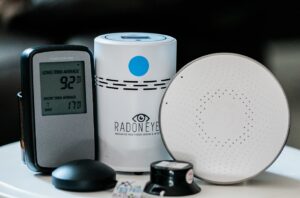Gas stoves: not just a problem for cooks, but the whole family
A new study of air pollution in U.S. homes has found that people living in homes in with gas stoves regularly breathe unhealthy levels of nitrogen dioxide (NO2), no matter where in the house they might be.
Our headline quotes Professor Rob Jackson of Stanford Doerr’s School of Sustainability who said: ‘I didn’t expect to see pollutant concentrations breach health benchmarks in bedrooms within an hour of gas stove use, and stay there for hours after the stove is turned off. It’s the whole family’s problem.’

Colin Finnegan of Stanford Doerr’s School of Sustainability prepares analysers outside a kitchen.
The researchers measured concentrations of NO2 in over 100 homes of various sizes, layouts, and ventilation methods, before, during, and after stove use. Using this data they could simulate airflow, transport of the pollutant and the subsequent room-by-room occupant exposure.
This allowed them to estimate nationwide averages and short-term exposures under a range of realistic conditions and behaviors, and cross-check model outputs against their home measurements.
Professor’s Jackson’s group have researched in this area previously, with work that has studied the rate at which gas stoves emit other pollutants such as methane and the benzene. Building on this, the next step was to establish how much pollutants spread through a home, the extent to which they build up, and the time it takes for them to dissipate.
Jackson explained: ‘We’re moving from measuring how much pollution comes from stoves to how much pollution people actually breathe.’
The researchers found that typical use of a gas stove increases exposure to NO2 by around 4 parts per billion – or 7.52 µg m³ – averaged over a year. This exposure rate would put members of the household three-quarters of the way to WHO’s NO2 limit of 10 µg m³, before they’ve even stepped out of their house.
There are ways to mitigate the worst levels of exposure but, as lead study author Yannai Kashtan, a PhD student in Earth system science said: ‘We found that just how much gas you burn in your stove is by far the biggest factor affecting how much you’re exposed. And then, after that, do you have an effective range hood – and do you use it?’
Obviously the size of the home affects exposure levels but even in the larger premises surveyed (around 3,000 ft²), unhealthy NO2 spikes were routinely measured, both during and after cooking.
More problematic is gas cooking in the smaller homes, typically the size of a two-bedroom apartment (around 800 ft²). Here residents could be exposed to twice as much NO2 over the course of a year compared to the national average, and four times as much as gas stove uses in the larger premises.
Concomitant with this is that poorer families will suffer greater exposure. Indeed, the researchers found that long-term NO2 exposure is 60% higher among American Indian and Alaska Native households, and 20% higher among Black and Hispanic or Latino households – a demographic who are already exposed to the highest levels of ambient CO2 such as vehicle exhaust.














